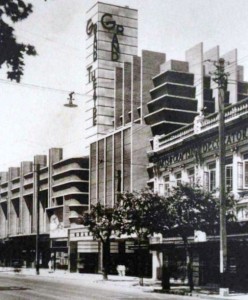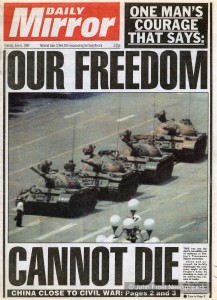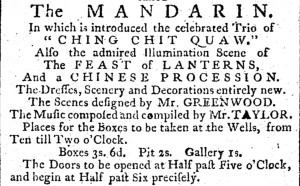Posted: June 9th, 2015 | No Comments »
Came across a reference the other day to the tale that the Grand Cinema, once known to Shanghailanders as ‘the best cinema of the Far East’, on the Bubbling Well Road (now the Grand Theatre on Nanjing West Road) was formerly a hotbed of illicit fun. Apparently, in the 1930s, the matinee performances were known for lesbian Shanghailanders sitting alone in the dark waiting to see who would sit next to them and then….Anyway, it’s a lovely Hudec-designed art-deco picture house so why not hook up in style!

Posted: June 8th, 2015 | No Comments »
The latest from Earnshaw Books is Andrew Hicks’s A True Friend to China: The Friends Ambulance Unit ‘China Convoy’, 1945-1951.

China in the late 1940s was another world, an ancient society still in the grips of feudalism, desperately poor and in need of modernisation. There are many formal histories of those pivotal and turbulent times but Jack Jones is among the few foreigners to have written contemporary accounts of day-to-day life there. Together with his fellow members of the Friends Ambulance Unit ‘China Convoy’, his long struggle to bring medical supplies and services to the poorest regions of China is vividly evoked in this book. Written by him as articles for the China Convoy’s newsletter and lost and unread for more than half a century, these have recently been discovered in Quaker archives in London and Philadelphia. An edited selection now tells the remarkable story of how Jack and his team battled against all the odds in life-threatening situations to help relieve the overwhelming suffering of the Chinese people.
Posted: June 7th, 2015 | No Comments »
RAS Lecture
June 9th 2015
7pm for 7.15pm
Â
Tavern at the Radisson Xingguo Hotel
DR. MAISIE MEYER on Shanghai Millionaires: Shanghai’s Baghdadi Jews

The Baghdadi Jews who came to Shanghai are legendary. The names Hardoon, Kadoorie and Sassoon were emblazoned over the business and social life of East Asia for over a century. They were exciting, dynamic personalities and their philanthropy spread far beyond the confines of the Treaty Port. Dr. Maisie Meyer digs behind the legend through her skillful use of archival material. Photographs permit us to visualise the lives and times of these individuals.
Dr. Meyer pioneered the research of the Baghdadi Jewish community of Shanghai, having appreciated over 30 years ago the unique mix represented by its various components. Over this period, she has forged relationships with many of the families and individuals who paid a large part in this burgeoning community. Her ground-breaking book ‘
From the Rivers of Babylon to the Whangpoo: A Century of Sephardi Jewish Life in Shanghai’ (Lanham M.D.2003) is widely considered as the definitive history of the Baghdadi Jewish merchants who settled in Shanghai in the mid-19th century. Her determination to preserve the memory of this community and the unrivalled access that she has enjoyed to both the key characters and previously unseen source material has resulted in her recent publication ‘
Shanghai’s Baghdadi Jews: A Collection of Biographical Reflections’.
Dr. Meyer is a double graduate in English and Humanities, both with honours, and obtained an MA degree in International History at the London School of Economics. The British Academy awarded her a scholarship to do a PhD. The subject she chose to research reflects her personal autobiography. It gives her a deeper understanding of Shanghai’s Baghdadi Jews, their emulation of a British lifestyle and their desire to appear as British as possible within the parameters of their faith.
ENTRANCE: Members 70 RMB, Non-members 100 RMB
Includes a glass of wine or soft drink
MEMBERSHIP applications and membership renewals will be available at this event.
WEBSITE: www.royalasiaticsociety.org.cn
Posted: June 6th, 2015 | No Comments »
I always rather liked Robert Byron as he was an English aesthete who traveled to Peking in the 1930s and didn’t like it!
 ‘…apart from the temples and palaces – all (Peking) is grey, the most positive and emphatic grey you ever saw – all the brick is grey – the landscape is as grey as an engraving – the tiles are grey, so is the air.’
Best remembered now as a travel writer, Robert Byron (1905-1941) was an English writer, art critic and historian. After an Eton and Oxford education he was, as a young man after the Great War (1914-1918) identifiable as one of the so-called Bright Young Things of London. He became a notable traveller-aesthete combining witty observations of placed visited with an appreciation of them through their indigenous art and architecture. Most notably Byron travelled to, and wrote about, Mount Athos, India, the Soviet Union and Tibet. However, it is his writing on his travels to Persia (Iran) and Afghanistan that are best remembered and brought him acclaim as a travel writer, outselling his closest rivals in the 1930s Peter Fleming and Evelyn Waugh.
His best selling and most critically acclaimed travelogue, The Road to Oxiana, was first published in 1937 and recounts his ten month journey in 19933 and 1934 to the Middle East with the novelist and biographer Christopher Sykes (1907-1986) searching for, what he believed were, the Central Asian roots of Islamic architecture. The pair visited Venice, Cyprus, Palestine, Syria, Iraq, Persia, Afghanistan and ending in Peshawar, India. While the book is a recognised best-seller and seen by many as a break out book for both the author and a certain style of travel writer and observation, what is less known is that the book was written during Byron’s 1935-1936 sojourn in Peking while planning a trip to Japan. While his Peking stay does not feature in the book it clearly had an influence on some of his writing and his post-visit impressions of his recent travels. Unlike many other traveller-aesthetes who resided for periods in Peking, such as Byron’s close friend and Oxford contemporary Harold Acton (1904-1994), he disliked the city fairly intensely writing, ‘This (Peking) is a place for cowards who have given up the struggle with the world, and I haven’t quite done that.’ Given Byron’s literary output while in Peking, his impressions of the city and China as well as his interactions with others while residing there, it is useful to look in more detail at Byron’s Peking period, his personal networks of acquaintances and his recorded impressions and thoughts regarding the city and country.
Robert Byron had not planned a trip to China and there are no indications that, among the many near and far east locations he desired to visit, Peking and/or China held much attraction for him. However, he did have a desire to visit Japan. After his journey across the Middle East to Afghanistan Byron appeared to be in no rush to produce his book of the trip, which had been commissioned by Macmillan. After some time spent writing a comic novel in England the Institute of Persian Architecture suggested a lecture tour of the United States. Before leaving London he showed some new drawings of Persia and Afghanistan at the Walker Gallery. In January 1935 Byron went to New York. He returned to England after several months in America but still did not work on the commissioned travel book of his Persian/Afghanistan trip but rather agreed to visit the International Congress and Exhibition of Persian Art and Archaeology that September at the Hermitage in Leningrad (St. Petersburg).
Byron was acquainted with Desmond Parsons who was living in Peking at the time. In Russia he reached as far east as Novo Sibirsk and, with an invitation to visit Parsons, decided to push on to China rather than return to England. His intention was to spend several months with Parsons completing the commissioned book and had the notion to visit Japan afterwards. Problems occurred with both exiting the Soviet Union overland at Vladivostok and also entering China through Manchuria, then occupied by the Japanese and annexed as Manchukuo. His plan to take the train from Vladivostok to Harbin but was unable to and so took a rather circuitous route via a ferry to Korea, a train to Hsinking (the capital of Japanese Manchukuo), from there to Mukden (where he vaguely knew the British Consul’s wife Alice Morland) and then to Tientsin (Tianjin) and on to Peking.
Eventually reaching Peking Byron had some acquaintances. His old Oxford contemporary and fellow aesthete Harold Acton was living in the city but his primary contact was Desmond Parsons. Parsons was born on 13 December 1910, the youngest of three children of the 5th Earl of Rosse, Birr, Co. Offaly, Ireland. Parsons attended Eton and was a “Bright Young Thing†in London after the Great War, along with Byron and Acton. Indeed it was Acton who encouraged Parsons to travel to China. He established himself in Peking, acquiring a courtyard house to the northeast of the Forbidden Palace, 8 Cuihua Hutong, off Morrison Street. Parsons embarked on a course in Chinese language while also translating a collection of Chinese folk tales from German into English. He taught at Peking University and wrote a column for the Peiping Chronicle newspaper. Inspired by Aurel Stein’s excavations at Dunhuang he journeyed there in 1935 producing a photographic record of the caves, despite attracting the ire of the Chinese authorities who, after Stein had removed many manuscripts and frescos, watched the caves closely for looters. However, Parsons had been suffering health problems, which were diagnosed as Hodgkin’s Disease (then believed to be non-fatal). Byron arrived to stay with his old friend in November 1935. However, it was decided that Parsons should travel to England for treatment that Christmas. He hoped to return to Peking and asked Byron to stay on and look after his courtyard house. Byron agreed.
From the start Byron and Peking seemed not to agree. Distraught at Parsons’s medical condition and departure he found trouble communicating with the Chinese (not yet speaking any of the language), came down with a severe bout of flu and probably a case of exhaustion after his recent travels in Russia. He spent January 1936 in a state of collapse but rallied in February and at last began work on The Road to Oxiana. His collection of notebooks from the long trip to Persia and Afghanistan (five or six diaries, a few odd sheets of notes and a batch of typescript) had by this time arrived safely from England, dispatched by his father.
When he had first arrived in November 1935 he had embarked, with Parsons when his health permitted, on the usual round of tourist sights, such routine Peking pleasures (such as having tweed suits, an evening suit and a number of shirts made for a fraction of the cost of London) and day trips including to the Great Wall. Parsons’s courtyard home was palatial, central (technically in the Eastern City District) and comprised of several courtyards with bamboo trees. He was housed in one pavilion with its own bathroom. Parsons also had other houseguests, Anne and Michael Parsons (Count and Countess of Rosse/Lady de Vesci respectively), his parents who were to depart for England with the ailing Desmond at Christmas.
He wrote at a large desk with a green leather top he had purchased and retained one servant and a head houseboy. He planned to write for two to three months to finish the manuscript. He was hoping to perhaps pick up some freelance journalistic work and indeed did being commissioned to write two articles on Siberia by Ralph Deakin, the Foreign News Editor for the London Times. Worried that his communication skills were poor he enrolled for Chinese lessons, noting the advances in the language made by both Parsons and Acton since their arrival in China. As a guest of the Parsons Byron was introduced to many leading British citizens in China including Sir Frederick Leith Ross, the chief economic adviser to the British government who happened to visiting the city at the time for the “Leith-Ross mission” in 1935, attempting to persuade China to reform its currency.
Already though, after only a few weeks in the city he did not feel impressed by Peking. Writing to his sister Anne (known in the family as Mibble) he declared in November 1935,
‘As for Chinese art and the beauty of Peking – I must wait for it grow on me, or not to do so. But of architecture in the real sense of the word, there is nothing. That I can see straight off. They can build a wall, and make it very big – they have an exquisite capacity for space and layout, both large and small – but cubically and intellectually it is all a vacuum.’

Â
Posted: June 5th, 2015 | No Comments »
If China’s city mayors these days aren’t on the take or spending most of their time with their multiple mistresses then they’re prudes who spend their time locking up young feminists or banning old ladies from dancing in parks. Wonder then at the remarkably liberal and practical views of 1936 Mayor of Tientsin (Tianjin) Hsiao Chen-ying. Hsiao, faced with quite a few streets of sin and red light areas in his town, took a somewhat different approach to the previous “Moral Mayors” who had tried to suppress the drugs, girls and gambling. His basic idea was that if the foreigners in their concessions in Tientsin could have gambling, horse racing and lotteries, then why shouldn’t the Chinese in their portion of the treaty port? Simply license these activities, tax them and use the money to support the building of roads, bridges and schools. Let people smoke opium and pay a tax. And, by the way, by liberalising the whole scene you’d stop corrupt coppers taking squeeze from the brothels and casinos.
Hsiao, is seems, was as good as his word, allowing 50 opium dealers to commence business. Still, apparently a rather bunch of strait-laced students objected and protested. The Japanese turned a blind eye, shrugged their shoulders and invaded the city anyway the next year.

Posted: June 2nd, 2015 | No Comments »
The Old Shanghai Cafe stood at 1405 Kern Street in Fresno. This ad is from Christmas 1935 and the place was still in operation a decade later advertising in the 1946 edition of the California Police Officers Journal. Now, I just found the ad, I’m afraid I don’t know Fresno at all. Still, it did have a Chinatown – Tulare Street was the heart of it along with G Street, F Street, China Alley and Kern Street. Competitive too it seems – Johnnie Gee had the Old Shanghai Cafe and round on Tulare was the New Shanghai Cafe (might be the same folk owning them though) and plenty more Chinese restaurants too…..













